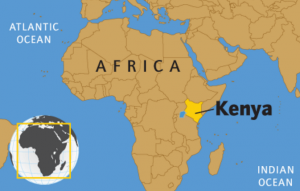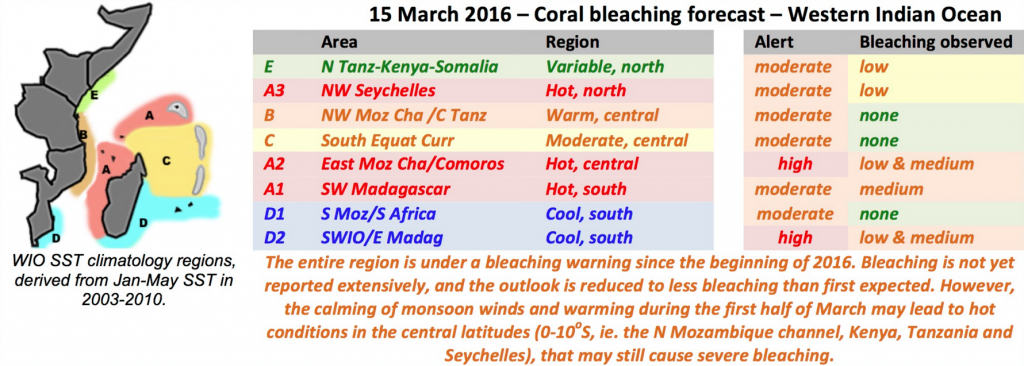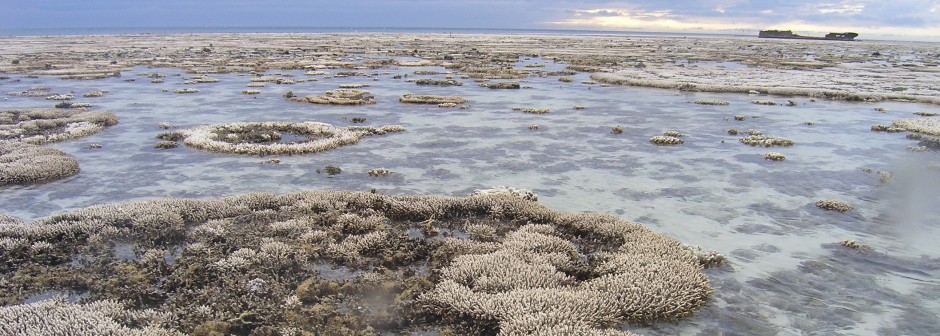Where are these reefs again?

Kenya is located on the eastern coast of Africa, and its reefs continue south to Tanzania. source: NG MAPS. “Map of Kenya.” Image. National Geographic Kids. Web. 16 Feb. 2016.
Well folks, where we left off last time the reefs off the coast of Kenya were at a huge risk of the highest severity level of bleaching predicted between the months of February and March 2016 [1]. As of 2008, most sites off Kenya were at an intermediate level of recovery from the 1997-1998 bleaching even that devastated all but 10% of coral cover in many places off Kenya’s coast [2][3]. An organization known as CORDIO, or Coastal Oceans Research and Development – Indian Ocean East Africa has been closely tracking bleaching events from January 1st of this year, and on March 2nd there was a report of a bleaching even (pictured below) off the coast of Mombasa [4].
![Bleaching observations as of Jan 1st, 2016. Yellow indicates low bleaching, orange indicates medium, and green indicates none. One low severity bleaching observation was reported off Mombasa on March 2nd 2016 by Jennifer O'Leary [2]](https://coralreefs.blogs.rice.edu/files/2016/03/bleaching-map-1b0xr7r.png)
Bleaching observations as of Jan 1st, 2016. Yellow indicates low bleaching, orange indicates medium, and green indicates none. One low severity bleaching observation was reported off Mombasa on March 2nd 2016 by Jennifer O’Leary. source: cordioea.net/bleaching_resilience/wio-coral-bleaching-alert/

Bleaching forecast for 2016. So far, minimal to no bleaching has occurred off Kenya’s coast, but it’s not out of danger quite yet. source: cordioea.net/wp-content/uploads/2016/03/Summary-160315.jpg
From the image above, we can gather that bleaching has been milder than predicted, with nearly no bleaching being observed off the Kenyan coast [5]. Though extensive bleaching has not yet been reported, the warming waters, low rainfall, and calming monsoon winds that characterize the northeast monsoon season could change that [3]. This shift in abiotic (nonliving) factors leaves reefs more prone to bleaching events [7]. Bleaching, and potentially severe bleaching is predicted to occur off Kenya before March [5].
Despite the relatively mild bleaching occurrences this year, we cannot be certain about the reefs’ future. Even though pressures from human civilization tend to be lower on average than other parts of the world, including Asia, Kenya and other eastern African countries have weaker governance structure and a lower overall capacity to respond to bleaching events [2]. To add to flimsy governmental management of the environment, eastern African countries tend to place a low priority on marine and coastal habitat maintenance [2]. Historically, problems do not get addressed until they become extremely pressing, and only then are attempts to resolve the issue made [2].
While pressures in the region tend to be lower than in Asia as population densities are lower and historical pressure has been much less, eastern African countries tend to have weaker governance structures and lower technical capability to manage impacts to the environment [7]. And apart from the small island states, marine and coastal issues tend to have a low priority for central governments and for society as a whole, so problems tend to persist and worsen before attempts at resolution are made [2].
References:
- NOAA Coral Reef Watch Methodology, Product Description, and Data Availability of NOAA Coral Reef Watch (CRW) Operational and Experimental Satellite Coral Bleaching Monitoring Products (2011) NOAA Satellite and Information Service.
- Obura, D.O., Tamelander, J., & Linden, O. (Eds) (2008). Ten years after bleaching – facing the consequences of climate change in the Indian Ocean. CORDIO Status Report 2008. Coastal Oceans Research and Development in the Indian Ocean/Sida-SAREC. Mombasa. http//:www.cordioea.org.
- McClanahan, T.R. (1988) Seasonality in East Africa’s coastal waters. Mar. Ecol. Prog. Ser. 44: 191-199.
- Wilkinson, C. (2008). Status of coral reefs of the world: 2008. Global Coral Reef Monitoring Network and Reef and Rainforest Research Centre, Townsville, Australia, 296 p.
- CORDIO: East Africa (2016) WIO Coral Bleaching Alert– what to expect?
- Perry, C. T. et al. (2013) Caribbean-wide decline in carbonate production threatens coral reef growth. Nat. Commun. 4:1402 doi: 10.1038/ncomms2409 .
- ICRI: Status of Coral Reefs of the World, 2008 (2008) 91- 96.

